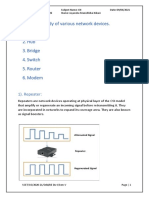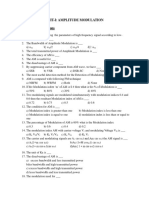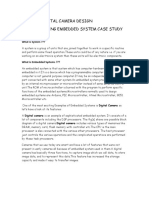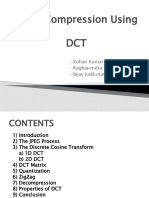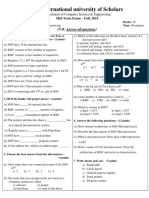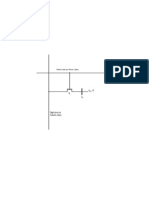DRAM Technology
Uploaded by
Harpreet MehraDRAM Technology
Uploaded by
Harpreet Mehra7 DRAM TECHNOLOGY
OVERVIEW
DRAM (Dynamic Random Access Memory) is the main memory used for all desktop and larger
computers. Each elementary DRAM cell is made up of a single MOS transistor and a storage
capacitor (Figure 7-1). Each storage cell contains one bit of information. This charge, however,
leaks off the capacitor due to the sub-threshold current of the cell transistor. Therefore, the charge
must be refreshed several times each second.
Bit Line
Word Line Transistor
Capacitor
Plate
Source: ICE, "Memory 1997" 19941
Figure 7-1. DRAM Cell
HOW THE DEVICE WORKS
The memory cell is written to by placing a “1” or “0” charge into the capacitor cell. This is done
during a write cycle by opening the cell transistor (gate to power supply or VCC) and presenting
either VCC or 0V (ground) at the capacitor. The word line (gate of the transistor) is then held at
ground to isolate the capacitor charge. This capacitor will be accessed for either a new write, a
read, or a refresh.
Figure 7-2 shows a simplified DRAM diagram. The gates of the memory cells are tied to the
rows. The read (or write) of a DRAM is done in two main steps as illustrated in Figure 7-3. The
row (X) and column (Y) addresses are presented on the same pads and multiplexed. The first
step consists of validating the row addresses and the second step consists of validating the
column addresses.
INTEGRATED CIRCUIT ENGINEERING CORPORATION 7-1
DRAM Technology
Address X
Row Decode
Pads
CAS
RAS
Y
Data
Sense
Data Amplifier
Data
Sense
Data Amplifier
Y Decode
Output
Dout
Buffer Data
Sense
Data Amplifier
Input
Din
Buffer
Data
Sense
Data Amplifier
Source: ICE, "Memory 1997" 22430
Figure 7-2. Simplified DRAM Diagram
RAS
Address Row Column
CAS
Step I Step II
Row Access Column Access
Source: ICE, "Memory 1997" 22431
Figure 7-3. DRAM Access Timing
7-2 INTEGRATED CIRCUIT ENGINEERING CORPORATION
DRAM Technology
First Step: Row Addresses
Row addresses are present on address pads and are internally validated by the RAS (Row Address
Access) clock. A bar on top of the signal name means this signal is active when it is at a low level.
The X addresses select one row through the row decode, while all the other non-selected rows
remain at 0V. Each cell of the selected row is tied to a sense amplifier. A sense amplifier is a cir-
cuit that is able to recognize if a charge has been loaded into the capacitor of the memory cell, and
to translate this charge or lack of charge into a 1 or 0. There are as many sense amplifiers as there
are cells on a row. Each sense amplifier is connected to a column (Y address). In this first step all
the cells of the entire row are read by the sense amplifier. This step is long and critical because the
row has a high time constant due to the fact that it is formed by the gates of the memory cells.
Also, the sense amplifier has to read a very weak charge (approximately 30 femtoFarads or 30fF).
Second Step: Column Addresses
Following the first step, column addresses are present on the address pads and are internally val-
idated by the Column Address Access (CAS) clock. Each selected memory cell has its data vali-
dated in a sense amplifier. Column access is fast. This step consists of transferring data present
in the sense amplifier to the Dout pin through the column decode and the output buffer. On
memory data sheets, the access time from RAS is termed tRAC and the access time from CAS is
listed as tCAC. On a typical standard DRAM of 60ns access time, tRAC = 60ns and tCAC = 15ns.
Refresh
To maintain data integrity, it is necessary to refresh each DRAM memory cell. Each row of cells
is refreshed every cycle. For example, if the product specification states, “Refresh cycle = 512
cycles per 8ms,” then there are 512 rows and each individual row must be refreshed every eight
milliseconds.
As explained above, during the row access step, all the cells from the same row are read by the
sense amplifier. The sense amplifier has two roles. Since it holds information within the cell, it is
able to transmit this data to the output buffer if it is selected by the column address. The sense
amplifier is also able to re-transmit (write) the information into the memory cell. In this case, it
“refreshes” the memory cell. When one row is selected, all the cells of that row are read by the
sense amplifiers and all these cells are refreshed one at a time.
Burst or distributed refresh methods can be used. Burst refresh is done by performing a series of
refresh cycles until all rows have been accessed. For the example given above, this is done every
8ms. During the refresh, other commands are not allowed. Using the distributed method and
the above example, a refresh is done every 12.6µs (8ms divided by 512). Figure 7-4 shows these
two modes.
INTEGRATED CIRCUIT ENGINEERING CORPORATION 7-3
DRAM Technology
Distributed
Refresh
Burst
Refresh
Time
Required Time To
Complete Refresh Of All Rows
Each Pulse Represents
a Refresh Cycle
Source: Micron, "Memory 1997" 20843
Figure 7-4. Burst and Distributed Refresh
For standard DRAMs there are three ways to perform refresh cycles. They are RAS-only refresh,
CAS-before-RAS refresh, and hidden refresh. To perform a RAS-only refresh, a row address is put
on the address lines and then RAS goes low. To perform a CAS-before-RAS refresh, CAS first goes
low and then a refresh cycle is performed each time RAS goes low. To perform a hidden refresh
the user does a read or write cycle and then brings RAS high and then low.
MEMORY CELL
A great deal of design effort has been made to shrink the cell area, particularly, the size of the
DRAM capacitor. As memory density increases, the cell size must decrease. Designers have man-
aged to shrink overall cell size. However, due to factors such as noise sensitivity and speed, it has
been a challenge to reduce the capacitance. The capacitance must stay in the range of 30fF.
The charge (Q) stored in a capacitor is equal to capacitance times voltage (Q = C x V). Over the
years, DRAM operating voltage has decreased (i.e., 12V to 5V to 3.3V). As voltage decreases, the
stored charge will also decrease. Design improvements allow for the decrease in the cell charge
as long as the capacitance remains in the range of 30fF.
Two main developments are used to reduce capacitor area without reducing its value. These are
the use of new capacitor shapes to fit into a minimum chip surface area and increasing the
dielectric constant.
Memory Cell Shape
The 1Mbit DRAM generation was the first to abandon the classical planar capacitor and replace it
with a trench or a stacked capacitor. Figure 7-5 shows the feature sizes of some of the DRAM
devices that ICE analyzed in its laboratory these two last years. Trench capacitors are not widely
used in spite of continual research and development on that type of design. As shown, the major
64Mbit DRAMs available on the market are today made of stacked capacitors.
7-4 INTEGRATED CIRCUIT ENGINEERING CORPORATION
DRAM Technology
Cell Area Die Area
Name Density Date Code Gate Length Cell Type
µm2 mm2
Fujitsu 16M 9532 1.4 97.8 0.30 Stacked
Mosel-Vitelic 4M 9518 4.0 65.0 0.55 Stacked
NEC 64M 9621 1.0 161.0 0.35 Stacked
IBM/Siemens 64M 9539 1.5 197.0 0.25 Trench
Samsung 64M 9552 1.2 159.3 0.35 Crown
Mitsubishi 16M 1995 3.0 100.1 0.45 Stacked
Hitachi 64M 9351 1.6 229.4 0.35 Stacked
Source: ICE, "Memory 1997" 22432
Figure 7-5. Physical Dimensions of DRAMs
Cross sections of 64Mbit DRAMs analyzed by ICE’s laboratory illustrate three major choices for
manufacturing DRAM memory cells. Hitachi uses a stacked, multi-layer capacitor for its 64Mbit
DRAM (Figure 7-6). The trench capacitor (Figure 7-7) is used by IBM/Siemens, and the simple
stack capacitor (Figure 7-8, and 7-9) is preferred by Samsung and NEC.
Photo by ICE, “Memory 1997” 19814
Figure 7-6. Hitachi 64Mbit DRAM Cross Section
Figure 7-10 shows how size cell improvements will be necessary for the next DRAM generations.
Figure 7-11 illustrates the stacked capacitor structure evolution. The decrease of cell size without
decreasing capacitor value results in increasing complexity of memory cell technology. Most lead-
ing DRAM manufacturers are working on 1Gbit cells. Their goal is to decrease the size of the cell
without compromising the value of the capacitor.
Two types of 1Gbit cell developments are shown in the next figures. Toshiba tried to improve the
trench capacitor concept by creating a bottle-shape trench design (Figure 7-12). Hitachi tried to
improve the stack concept with a vertical and circular capacitor (Figure 7-13). NEC received a
patent from the U.S. Patent Office for its proprietary HSG (hemispherical-grain) silicon technology.
INTEGRATED CIRCUIT ENGINEERING CORPORATION 7-5
DRAM Technology
METAL 3 METAL 2
METAL 1
POLY 1 TRENCH
CAPACITORS
Photo by ICE, “Memory 1997” 22433
Figure 7-7. IBM/Siemens 64Mbit DRAM Cross Section
POLY 5 CAPACITOR SHEET
POLY 4
CAPACITOR NITRIDE
PLATE ETCH-STOP
LAYER
“STEM” POLY 2 BIT LINE
CONTACT
REFLOW GLASS
POLY 2 BIT
CONTACT PAD
N+ S/D POLYCIDE 1 SELECT GATE
Photo by ICE, “Memory 1997” 20844
Figure 7-8. Samsung 64Mbit DRAM Cross Section
CAPACITOR POLY 4 CAPACITOR SHEET
DIELECTRIC
POLY 3
CAPACITOR
PLATE
POLY 3
“STEM”
POLY 2 BIT LINE
Photo by ICE, “Memory 1997” 22434
Figure 7-9. NEC 64Mbit DRAM Cross Section
7-6 INTEGRATED CIRCUIT ENGINEERING CORPORATION
DRAM Technology
103 10
Chip Area
102 1.0
Chip Area (mm2), Cell Area (µm2)
Minimum
Minimum Feature Size (µm2)
Feature Size
101 0.1
1 Cell Area 0.01
10-1
256K 1M 4M 16M 64M 256M 1G 4G
DRAM Generation (bits)
Source: Hitachi/ICE, "Memory 1997" 20775A
Figure 7-10. DRAM Technology Trend
CAPACITOR DIELECTRICS
The inability to scale the capacitor value has led to the consideration of new dielectric materials for
the capacitor. It is likely that materials with higher dielectrics will see more use. Many of the mate-
rials have proven track records through their use as dielectrics in discrete capacitors. Therefore, the
main challenge is the introduction of these materials into the IC process. Figure 7-14 shows some
of the materials under consideration. Tantalum Pentoxide (Ta2O5) has been viewed in several of
the 64Mbit DRAMs analyzed by the ICE laboratory. Ta2O5 seems that it could serve as a good
dielectric since it can easily be integrated into conventional stack capacitor structure. However, it
requires higher dielectric thickness, resulting in only a marginal improvement in capacitance.
PERFORMANCE
Compared with other memory ICs, DRAMs suffer from a speed problem. The on-chip circuitry
required to read the data from each cell is inherently slow. As such, DRAM speeds have not kept
pace with the increased clock speed of CPUs.
INTEGRATED CIRCUIT ENGINEERING CORPORATION 7-7
DRAM Technology
,,,,,
,,,,,
,,,,,
,,,,,,,,
,,,,,,,,
,,,,,,,,
Planar
,,,,,,,,
,,,,,,,,
HSG Crown
,,,,,,,,
Cup
,,,,,,,,
,,,,,,,,
,,,,,,,,
,,,,,,,,
,,,,,,,,
,,,,,,,, Multilayer Fin
Simple Stack
,,,,,,,,
,,,,,,,, ,,,,,,,,
,,,,,,,,
,,,,,,,, ,,,,,,,,
Simple Crown Multilayer Crown
Source: IBM/Semiconductor International/ICE, "Memory 1997" 22435
Figure 7-11. Stack Capacitor Structure Evolution
,,,, ,,,, ,,,, ,,,, ,,,, ,,,, ,,,, ,,,,,
,,,, ,,,, ,,,, ,,,, ,,,, ,,,, ,,,, ,,,,,
,,,, ,,,, ,,,, ,,,, ,,,, ,,,, ,,,, ,,,,,
Si RIE In-situ Doped Annealing Chemical
Poly-Si Dry Etching
Deposition Impurity
Doping Into
the Plate
Electrode
Source: Toshiba/ICE, "Memory 1997" 20767
Figure 7-12. Capacitor Manufacturing Process
7-8 INTEGRATED CIRCUIT ENGINEERING CORPORATION
DRAM Technology
TiN Plate Electrode
Poly-Si Electrode
Ta2O5
,,,
,,,, ,,,,,
Bit Line
,, ,,
,,,,
,,,
,,,,
,,, ,,,
,,,,,
,,,
,,,,,
,,,
Poly-Si Plug
,,,,,,,,,,,,,,,,,
,,,,,,,,,,,,,,,,,
,,,,,,,,,,,,,,,,,
LOCOS
Si Substrate
Source: Hitachi/ICE, "Memory 1997" 20766
Figure 7-13. Schematic Cross-Sectional View of CROWN-Type Memory Cell
Material εr
SiO2 3.8
SiN4 7.9
Ta2O5 20 - 30
BaTiO3 15 - 30
SrTiO3 15 - 30
TiO2 35 - 50
Polyimide 2 - 2.6
Source: ICE, "Memory 1997" 18741
Figure 7-14. Capacitor Dielectric Constants
Early microprocessor systems were introduced with clock speeds of 1MHz (one million cycles
per second). Today, CPUs in desktop PCs are 200MHz and faster, at least a 200x improvement.
Early DRAMs had access cycle times (the time required for the DRAM chip to supply the data
back to the CPU) of 250 nanoseconds (ns). The fastest DRAM units today are about 50ns, a five-
fold improvement.
To face this speed discrepancy, DRAMs have branched into many sub-categories. Each features a
variation of system interface circuitry with the intent of enhancing performance. Furthermore, each
design attempts to answer needs of specific applications. Current offerings are shown Figure 7-15.
INTEGRATED CIRCUIT ENGINEERING CORPORATION 7-9
DRAM Technology
FPM (Fast Page Mode)
EDO (Extended Data Out)
Standard
BEDO (Burst EDO)
ARAM (Audio RAM)
EDRAM (Enhanced DRAM)
Cache
CDRAM (Cache DRAM)
SDRAM (Synchronous DRAM)
Synchronous SDRAM II or DDR DRAM (Double Data Rate DRAM)
SGRAM (Synchronous Graphic DRAM)
Cache Synchronous ESDRAM (Enhanced SDRAM)
DRAM
VRAM (Video RAM)
Video
WRAM (Window RAM)
PSDRAM (Pseudo Static RAM)
Pseudo Static
Fusion
RDRAM (Rambus)
SLDRAM (SyncLink)
Other Configurations 3D
nDRAM (Next Generation)
MDRAM (Multi Bank)
Other Technology FRAM (Ferroelectric DRAM)
Source: ICE, "Memory 1997" 22450
Figure 7-15. Current DRAM Varieties
Fast Page Mode DRAMs
To access DRAM data, a row address is applied, followed by a column address. The addresses of
a DRAM are multiplexed on the same package pins. When requested data is stored in the same
row as previously requested data, merely changing the column address allows access to this new
data. Therefore, with fast page mode, the data of the same row can be accessed by changing only
the column address.
As an example, consider a 1Mbit DRAM that has an array organization of 1,024 x 1,024 bits. 1,024
bits of data belong to the same row. This data will be accessible through fast page mode (a row is
considered a page). This mode is available on all the standard DRAMs. As described previously,
this access time is as fast as the data available in the sense amplifier.
7-10 INTEGRATED CIRCUIT ENGINEERING CORPORATION
DRAM Technology
Static column mode is similar to page mode except that only the column address needs to be
changed to obtain the new data, and no CAS pulse is needed. Nibble mode groups memory cells
in “four bits per nibble” so that whenever one bit is selected, four serial bits appear. This mode is
no longer widely used.
Extended Data Out (EDO) DRAMs
Extended data out DRAMs (EDO DRAMs), also called hyper-page-mode DRAMs, represent a
small design change in the output buffer relative to a standard fast page mode DRAM. The old
data is latched at the output while new data is addressed. EDO shortens the effective page mode
cycle time as the valid data output time is extended.
For the same technology, a product in standard mode may have a cycle time of 110ns (access time
of 60ns). This cycle time will be reduced to 40ns in fast page mode and to 25ns in EDO mode.
Burst EDO DRAMs
Several vendors offer burst versions of the EDO DRAM. The “burst” refers to the fact that all read
and write cycles occur in bursts of four, automatically sequenced by the memory chip. To accom-
plish that, a special pipeline stage and a two-bit counter are added.
The Burst EDO DRAM read access time differs from EDO DRAM in two ways. First, as the output
latch is replaced by a special pipeline stage (register), the latency will be higher but the bandwidth
will be better. Second, as the Burst EDO DRAM includes an internal address counter, only the ini-
tial address in a burst of four needs to be provided.
Manufacturers may use the same mask set for their fast page mode EDO and burst EDO DRAMs.
A wire bond option determines which product is in the final package. Figure 7-16 shows timing
differences between the various standard DRAMs. Figure 7-17 shows speed differences.
Audio DRAMs
Due to process defects during wafer probe, some DRAMs wind up with a few failed storage cells
that cannot be effectively repaired (or replaced) by the redundancy mechanism. These cannot
be sold as good devices to PC OEMs. However, a few defective bits do not affect an audio appli-
cation where there is a tolerance for error. For this reason manufacturers may sell parts with few
bad cells for use in audio applications. These devices are called Audio DRAM (ARAM). The
client can buy ARAMs cheaper than a standard DRAM.
INTEGRATED CIRCUIT ENGINEERING CORPORATION 7-11
DRAM Technology
RAS RAS
CAS CAS
Address ,,,
,,,R C ,,,,,,
,,,,,,
Address ,,
,, R C C C C C,,,,
,,,,
Dout Dout 1 2 3 4 n
NORMAL MODE STATIC COLUMN MODE
RAS RAS
CAS CAS
Address
,,
,, R C,,,,,
,,,,,,,,,,
,,,,,
C C
,,,,,
,,,,, Address ,,
,,R C
,,
,, C ,,
,, C,,,
,,,C ,,,
,,,
Dout 1 2
Dout 1 2 3
FAST PAGE MODE
EDO
RAS RAS
CAS CAS
Address ,, ,,,,,,,,,,,,,,,
,, R C,,,,,,,,,,,,,,, Address ,, ,,,,,,,,,,,,,,,
,, R C,,,,,,,,,,,,,,,
Dout 1 2 3 4 Dout 1 2 3 4
NIBBLE MODE BURST EDO
R: Row Address
C: Column Address
Source: ICE, "Memory 1997" 22436
Figure 7-16. Comparison of Dynamic RAM High Speed Access Modes
DRAM Type
DRAM Speed
(tRAC) Fast Page Burst
EDO
Mode EDO
70ns 25MHz 33MHz 50MHz
60ns 28MHz 40MHz 60MHz
50ns 33MHz 50MHz 66MHz
Source: Micron/ICE, "Memory 1997" 19992A
Figure 7-17. Comparison of Standard DRAM Performances
Cache DRAMs
Another DRAM alternative is the cache DRAM (CDRAM) developed by Mitsubishi. This device
integrates a 16Mbit DRAM and a L2 (level two) SRAM cache memory (16Kbit SRAM) on the same
chip. The transfer between the DRAM and the SRAM is performed in one clock cycle through a
buffer of 8 x 16 bits. The SRAM is a six-transistor cell. The SRAM access/cycle time is 15ns.
Currently, Mitsubishi and Samsung offer CDRAM devices. Figure 7-18 shows the chip organiza-
tion of a CDRAM.
7-12 INTEGRATED CIRCUIT ENGINEERING CORPORATION
DRAM Technology
SRAM Address
4K x 4 Fast SRAM Cache
Address Latch
Clock
Cache Hit
DRAM
CS, Write Enable 64-Bit Buffer 64-Bit Buffer Data
Control
Control
Refresh
Multiplexed Address 1M x 4 DRAM Array
DRAM Address Latch
Source: EBN/ICE, "Memory 1997" 20756
Figure 7-18. Cache DRAM
Enhanced DRAMs
Enhanced DRAMs (EDRAMs) were developed by Ramtron Corporation. The EDRAM is also sold
by IBM (3.3V and 5V parts), as IBM and Ramtron have a second source agreement for this prod-
uct. The EDRAM architecture is similar to a standard 4Mbit page mode or static column DRAM
with the addition of an integrated L2 SRAM cache and internal control. Technically, the EDRAM
is a cache DRAM (CDRAM). Rather than integrate a separate SRAM cache, the EDRAM takes
advantage of the internal architecture of a standard fast page mode DRAM, which has sense
amplifiers that act like a 2Kbit SRAM cache when reading and accessing data.
Memory read cycles always occur from the cache. When the comparator detects a hit, only the
SRAM is addressed where data is available in 15ns. When a miss is detected, the entire cache is
updated and data is available at the output within a single 35ns access. Figure 7-19 shows the chip
organization of an EDRAM.
Column Access Signal Column Address 512 x 4 Page
Ground
Latch Cache (SRAM) Read
Column Data
Last Row Read Decoder I/O Set
Address Address Latch Control
Lines and
Sense Amps and Data
Row Write Select Write Latches Write Enable
Address Latch Data
Refresh Control Pin
Flow Address and DRAM Array Data
Read/Write Control Refresh
Refresh Counter (2,048 x 512 x 4)
Row Access Signal Address
Source: EBN/ICE, "Memory 1997" 20757
Figure 7-19. Enhanced DRAM (EDRAM)
INTEGRATED CIRCUIT ENGINEERING CORPORATION 7-13
DRAM Technology
Synchronous DRAMs
Synchronous DRAMs represent the next step in the evolution of the industry standard DRAM
architecture. Synchronous DRAMs (SDRAMs) have their read and write cycles synchronized
with the processor clock. The SDRAM is designed with two separate banks. These two indepen-
dent banks allow each bank to have different rows active at the same time. This allows concur-
rent access/refresh and recharge operations. Figure 7-20 presents a block diagram organization
of an SDRAM.
DQMU
DQML
CAS#
RAS#
WE#
CKE
CLK
CS#
Address Bus
Control Logic and A8 A9-A0
Timing Generator
A9-A0 A9 A7-A0 A9-A0 Refresh Counter
Mode Register
Burst Counter Column Address Latch Row Address Latch
MUX
Row Decorder Row Decorder
512 Rows 512 Rows
Sense Amps
Sense Amps
Columns
Columns
Decoder
Decoder
Column
Column
256
256
Memory Array Bank 0 Memory Array Bank 1
CAS #
Output Latch Input Latch
Latency Control /Buffer
Output Latch
Output Buffer
Data Bus
Source: Hitachi/ICE, "Memory 1997" 22437
Figure 7-20. 4Mbit SDRAM Block Diagram
The SDRAM is programmed using a mode register. The programmable features include burst
length (1, 2, 4, 8, full page), wrap sequence (sequential/interleave), and CAS latency (1, 2, 3).
Figure 7-21 shows an SDRAM timing sequence. This timing illustrates the different possibilities
of CAS latency and of burst length.
7-14 INTEGRATED CIRCUIT ENGINEERING CORPORATION
DRAM Technology
CLK
tRCD
Active Read
Command
Row Column
Address
CL = 1 Out 0 Out 2
Out 1 Out 3
CL = 2 Out 1 Out 3
Dout
Out 0 Out 2
CL = 3 Out 0 Out 2
Out 1 Out 3
CL: CAS Latency
Burst Length = 4
BURST LENGTH
CLK
tRCD
Active Read
Command
Row Column
Address
BL = 1 Out 0
BL = 2 Out 0
Out 1
BL = 4 Out 0 Out 2
Dout
Out 1 Out 3
BL = 8 Out 0 Out 2 Out 4 Out 6
Out 1 Out 3 Out 5 Out 7
BL = Full Page Out 0 Out 2 Out 4 Out 6 Out 8 Out 256 Out 1
Out 1 Out 3 Out 5 Out 7 Out 0
BL: Burst Length
CAS: Latency = 2
Source: Hitachi/ICE, "Memory 1997" 22439
Figure 7-21. SDRAM Timing
The size of the mode register is equivalent to the number of address pins on the device and is writ-
ten during a mode register set cycle. This mode register must be reprogrammed each time any of
the programmable features have to be modified. Figure 7-22 illustrates the content of a register
for a 4Mbit SDRAM. Figure 7-23 shows a summary of the SDRAM functionality.
SDRAM-II or DDR DRAMs (Double Data Rate DRAMs)
The purpose of the DDR DRAM is to read data of an SDRAM at two times the frequency clock. The
device delivers data on both edges of the clock, doubling effective bandwidth at a given frequency.
INTEGRATED CIRCUIT ENGINEERING CORPORATION 7-15
DRAM Technology
A9 A8 A7 A6 A5 A4 A3 A2 A1 A0
OPCODE 0 LMODE BT BL
A6 A5 A4 CAS Latency A3 Burst Type Burst Length
0 0 0 R A2 A1 A0
0 Sequential BT=0 BT=1
0 0 1 1 1 Interleave 0 0 0 R R
0 1 0 2 0 0 1 2 2
0 1 1 3 0 1 0 4 4
1 X X R 0 1 1 8 8
1 0 0 R R
A9 A8 Write Mode 1 0 1 R R
0 0 Burst Read and Burst Write 1 1 0 R R
0 1 R 1 1 1 F.P. R
1 0 Burst Read and Single Write
1 1 R
F.P. = Full Page
R = Reserved (inhibit)
Source: Hitachi/ICE, "Memory 1997" 22438
Figure 7-22. Register Content of a 4Mbit SDRAM
CLK: External Clock Input and Synchronous DRAM Operations Synchronize with this Signal
CLK
Command:
Command Controls Synchronous DRAM Operation
Active Read
(CS,RAS,CAS,WE) Command is a Combination of CS,
RAS, CAS, and WE Signals.
Address
(A0 to A8) Row Column
Bank Select:
Bank Select A Memory Contains 2 Banks (Areas)
BS BS that can be Controlled Independently.
(A9)
BANK SELECT is used to Select a Bank.
Dout Out 0 Out 1 Out 2 Out 3
CAS Latency = 3 Burst Length = 4
Active Command Read Command
Set Cycle Set Cycle
CAS Latency: Clock Numbers from Burst Length: Possible Consecutive
Read Command Set to Data Output Input/Output Data Length
Source: Hitachi/ICE, "Memory 1997" 22440
Figure 7-23. SDRAM Functionality
7-16 INTEGRATED CIRCUIT ENGINEERING CORPORATION
You might also like
- Logic Exam - Bank Questions - Assuit UniversityNo ratings yetLogic Exam - Bank Questions - Assuit University10 pages
- Implementing 7 4 Hamming Code Encoding and Decoding System Using CPLD IJERTV2IS70300No ratings yetImplementing 7 4 Hamming Code Encoding and Decoding System Using CPLD IJERTV2IS703006 pages
- Digital Image Processing: Huffman Coding ExampleNo ratings yetDigital Image Processing: Huffman Coding Example3 pages
- Department of Computer Science National Tsing Hua University CS4100 Computer ArchitectureNo ratings yetDepartment of Computer Science National Tsing Hua University CS4100 Computer Architecture3 pages
- Full Solution Manual For Modern Processor Design by John Paul Shen and Mikko H. Lipasti50% (2)Full Solution Manual For Modern Processor Design by John Paul Shen and Mikko H. Lipasti27 pages
- Midterm Solution - COSC 3213 - Computer Networks 1No ratings yetMidterm Solution - COSC 3213 - Computer Networks 113 pages
- Chapter Two (Part 2) Data Link Layer Protocols (Q & A)No ratings yetChapter Two (Part 2) Data Link Layer Protocols (Q & A)14 pages
- Design and Analysis of Algorithms: Time Space Trade OffNo ratings yetDesign and Analysis of Algorithms: Time Space Trade Off6 pages
- Practical 1: Study of Various Network Devices. 1. Repeater 2. Hub 3. Bridge 4. Switch 5. Router 6. ModemNo ratings yetPractical 1: Study of Various Network Devices. 1. Repeater 2. Hub 3. Bridge 4. Switch 5. Router 6. Modem13 pages
- Vtunotesbysri: Module 1: Application LayerNo ratings yetVtunotesbysri: Module 1: Application Layer30 pages
- Image Compression Using DCT: - Rohan Kumar Sinha - Raghavendra Karthik D - Bijay Kalikotay100% (1)Image Compression Using DCT: - Rohan Kumar Sinha - Raghavendra Karthik D - Bijay Kalikotay30 pages
- Systems For Digital Signal Processing: 1 - IntroductionNo ratings yetSystems For Digital Signal Processing: 1 - Introduction21 pages
- Performance Analysis of 32-Bit Array Multiplier With A Carry Save Adder and With A Carry-Look-Ahead AdderNo ratings yetPerformance Analysis of 32-Bit Array Multiplier With A Carry Save Adder and With A Carry-Look-Ahead Adder4 pages
- The Decision-Feedback Equalizer A Circuit For All SeasonsNo ratings yetThe Decision-Feedback Equalizer A Circuit For All Seasons5 pages
- The Memory System: Fundamental ConceptsNo ratings yetThe Memory System: Fundamental Concepts115 pages
- Computer Graphics Question For Final ExamNo ratings yetComputer Graphics Question For Final Exam3 pages
- DR - Chao Tan, Carnegie Mellon University: Computer Organization Computer ArchitectureNo ratings yetDR - Chao Tan, Carnegie Mellon University: Computer Organization Computer Architecture221 pages
- Chapter 02 Computer Organization and Design Fifth Edition The Hardware Software Interface The Morgan Kaufmann Series in Computer Architecture and DNo ratings yetChapter 02 Computer Organization and Design Fifth Edition The Hardware Software Interface The Morgan Kaufmann Series in Computer Architecture and D93 pages
- SMDP - Project - Final - Proposal - NIT - N - Draft PDFNo ratings yetSMDP - Project - Final - Proposal - NIT - N - Draft PDF17 pages
- The International University of Scholars: Department of Computer Science & EngineeringNo ratings yetThe International University of Scholars: Department of Computer Science & Engineering1 page
- How Delta-Sigma Adcs Work, Part 1: by Bonnie BakerNo ratings yetHow Delta-Sigma Adcs Work, Part 1: by Bonnie Baker6 pages
- Design and Simulation of Wireless Sensor Network in Ns2No ratings yetDesign and Simulation of Wireless Sensor Network in Ns23 pages
- Final Exam, 10701 Machine Learning, Spring 2009: Max. Score Score 1 2 3 4 5 6 7 8 9 10No ratings yetFinal Exam, 10701 Machine Learning, Spring 2009: Max. Score Score 1 2 3 4 5 6 7 8 9 1025 pages
- Understanding DRAM Operation: Figure 1: IBM Trench Capacitor Memory CellNo ratings yetUnderstanding DRAM Operation: Figure 1: IBM Trench Capacitor Memory Cell10 pages
- TLE ICT CSS 9 Q2 - Module1 PMC For Student - 085559No ratings yetTLE ICT CSS 9 Q2 - Module1 PMC For Student - 08555924 pages
- IT Essentials (ITE v6.0) A+ Cert Practice Exam 1 Answers 2016No ratings yetIT Essentials (ITE v6.0) A+ Cert Practice Exam 1 Answers 201621 pages
- 5tdm2 User Manual 6085354ade3c2664738054No ratings yet5tdm2 User Manual 6085354ade3c266473805452 pages
- Spruii0b-Microcontrollers Technical Reference PDFNo ratings yetSpruii0b-Microcontrollers Technical Reference PDF4,991 pages
- SoC-FPGA Design Guide (DE0-Nano-SoC Edition)No ratings yetSoC-FPGA Design Guide (DE0-Nano-SoC Edition)100 pages
- Infineon-S25FL512S 512 MB (64 MB) 3.0 V SPI Flash Memory-DataSheet-v20 00-ENNo ratings yetInfineon-S25FL512S 512 MB (64 MB) 3.0 V SPI Flash Memory-DataSheet-v20 00-EN161 pages
- Preliminary: Dual Socket 370 Pentium Iii SBC With Vga/Dual Lan/Scsi (133 MHZ FSB)No ratings yetPreliminary: Dual Socket 370 Pentium Iii SBC With Vga/Dual Lan/Scsi (133 MHZ FSB)1 page
- Atmel AVR32839: AVR UC3 Audio Player: 32-Bit Atmel Microcontroller Application NoteNo ratings yetAtmel AVR32839: AVR UC3 Audio Player: 32-Bit Atmel Microcontroller Application Note27 pages
- JEDEC Standard No. 21 - C Page 3.11.5.1 - 1No ratings yetJEDEC Standard No. 21 - C Page 3.11.5.1 - 120 pages
- Implementing 7 4 Hamming Code Encoding and Decoding System Using CPLD IJERTV2IS70300Implementing 7 4 Hamming Code Encoding and Decoding System Using CPLD IJERTV2IS70300
- Department of Computer Science National Tsing Hua University CS4100 Computer ArchitectureDepartment of Computer Science National Tsing Hua University CS4100 Computer Architecture
- Full Solution Manual For Modern Processor Design by John Paul Shen and Mikko H. LipastiFull Solution Manual For Modern Processor Design by John Paul Shen and Mikko H. Lipasti
- Midterm Solution - COSC 3213 - Computer Networks 1Midterm Solution - COSC 3213 - Computer Networks 1
- Chapter Two (Part 2) Data Link Layer Protocols (Q & A)Chapter Two (Part 2) Data Link Layer Protocols (Q & A)
- Design and Analysis of Algorithms: Time Space Trade OffDesign and Analysis of Algorithms: Time Space Trade Off
- Practical 1: Study of Various Network Devices. 1. Repeater 2. Hub 3. Bridge 4. Switch 5. Router 6. ModemPractical 1: Study of Various Network Devices. 1. Repeater 2. Hub 3. Bridge 4. Switch 5. Router 6. Modem
- Image Compression Using DCT: - Rohan Kumar Sinha - Raghavendra Karthik D - Bijay KalikotayImage Compression Using DCT: - Rohan Kumar Sinha - Raghavendra Karthik D - Bijay Kalikotay
- Systems For Digital Signal Processing: 1 - IntroductionSystems For Digital Signal Processing: 1 - Introduction
- Performance Analysis of 32-Bit Array Multiplier With A Carry Save Adder and With A Carry-Look-Ahead AdderPerformance Analysis of 32-Bit Array Multiplier With A Carry Save Adder and With A Carry-Look-Ahead Adder
- The Decision-Feedback Equalizer A Circuit For All SeasonsThe Decision-Feedback Equalizer A Circuit For All Seasons
- DR - Chao Tan, Carnegie Mellon University: Computer Organization Computer ArchitectureDR - Chao Tan, Carnegie Mellon University: Computer Organization Computer Architecture
- Chapter 02 Computer Organization and Design Fifth Edition The Hardware Software Interface The Morgan Kaufmann Series in Computer Architecture and DChapter 02 Computer Organization and Design Fifth Edition The Hardware Software Interface The Morgan Kaufmann Series in Computer Architecture and D
- SMDP - Project - Final - Proposal - NIT - N - Draft PDFSMDP - Project - Final - Proposal - NIT - N - Draft PDF
- The International University of Scholars: Department of Computer Science & EngineeringThe International University of Scholars: Department of Computer Science & Engineering
- How Delta-Sigma Adcs Work, Part 1: by Bonnie BakerHow Delta-Sigma Adcs Work, Part 1: by Bonnie Baker
- Design and Simulation of Wireless Sensor Network in Ns2Design and Simulation of Wireless Sensor Network in Ns2
- Final Exam, 10701 Machine Learning, Spring 2009: Max. Score Score 1 2 3 4 5 6 7 8 9 10Final Exam, 10701 Machine Learning, Spring 2009: Max. Score Score 1 2 3 4 5 6 7 8 9 10
- Understanding DRAM Operation: Figure 1: IBM Trench Capacitor Memory CellUnderstanding DRAM Operation: Figure 1: IBM Trench Capacitor Memory Cell
- TLE ICT CSS 9 Q2 - Module1 PMC For Student - 085559TLE ICT CSS 9 Q2 - Module1 PMC For Student - 085559
- IT Essentials (ITE v6.0) A+ Cert Practice Exam 1 Answers 2016IT Essentials (ITE v6.0) A+ Cert Practice Exam 1 Answers 2016
- Infineon-S25FL512S 512 MB (64 MB) 3.0 V SPI Flash Memory-DataSheet-v20 00-ENInfineon-S25FL512S 512 MB (64 MB) 3.0 V SPI Flash Memory-DataSheet-v20 00-EN
- Preliminary: Dual Socket 370 Pentium Iii SBC With Vga/Dual Lan/Scsi (133 MHZ FSB)Preliminary: Dual Socket 370 Pentium Iii SBC With Vga/Dual Lan/Scsi (133 MHZ FSB)
- Atmel AVR32839: AVR UC3 Audio Player: 32-Bit Atmel Microcontroller Application NoteAtmel AVR32839: AVR UC3 Audio Player: 32-Bit Atmel Microcontroller Application Note





















